This article was published in Scientific American’s former blog network and reflects the views of the author, not necessarily those of Scientific American
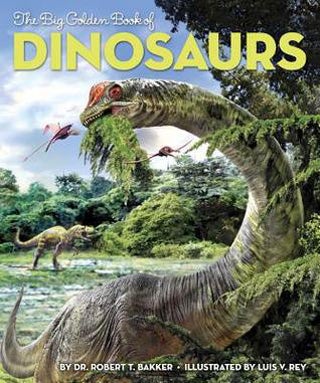
Front cover of Bakker (2013).
Continuing with my series of articles on recently-ish published dinosaur-themed books (see links below for the other articles), let’s look at Robert Bakker’s The Big Golden Book of Dinosaurs, published in 2013 (Bakker 2013). The Big Golden Book of Dinosaurs is very obviously intended as a modern re-vamped version of a classic, influential and much-loved book for kids: the original Dinosaurs and Other Prehistoric Reptiles of 1960, written by Jane W. Watson and illustrated by Rudolph F. Zallinger (Watson 1960).
A great many people over the age of – I dunno – 30-something remember this book fondly. It was, and still is, a joy to look at, and was the defining popular volume on dinosaurs for a great many people. Watson’s text – though obviously dated in many respects – is lively, active and fun, and does a surprisingly good job of conveying the fact that Mesozoic dinosaurs and their contemporaries evolved over vast swathes of time and inhabited discrete regions and chunks of time.
On supporting science journalism
If you're enjoying this article, consider supporting our award-winning journalism by subscribing. By purchasing a subscription you are helping to ensure the future of impactful stories about the discoveries and ideas shaping our world today.
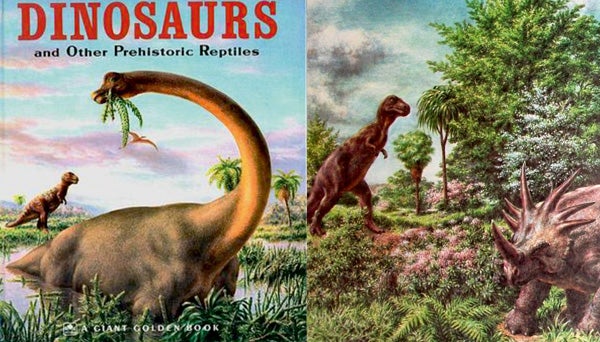
Cover of Watson's 1960 original at left, art by Rudolph Zallinger. At right: segment from a double-page Cretaceous scene, included not for the vintage dinosaurs but for Zallinger's amazing and wonderful flora. Many of Zallinger's dinosaurs were based on those of the brilliant Zdeněk Burian.
Zallinger’s art is wonderful. I love looking at these pictures, my favourite thing about them being the detailed, seemingly accurate* look of the extensive flora, and the landscapes and environments that the animals are set within. Virtually every scene is a packed visual feast with sweeping vistas, distant horizons, foregrounds and backgrounds. Many of his images are so iconic and well crafted that they spawned various of those palaeoart memes that are such an integral part of palaeontological art history.
* The flora is not literally accurate. Zallinger often posed his dinosaurs alongside cycads, palms and other tropical-looking plants that aren’t actually right at all for the scenes concerned.
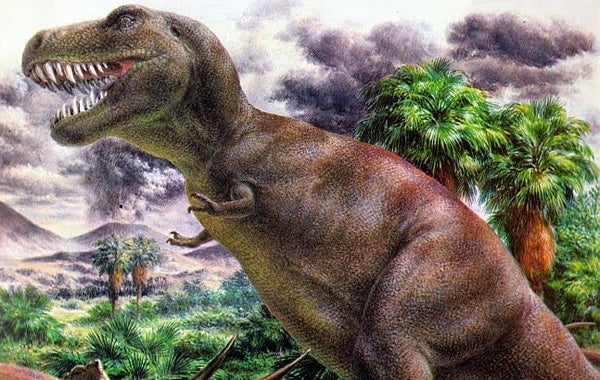
Zallinger's art of 1960 is really amazing - I include this image of his Tyrannosaurus so can you can appreciate the volcanoes and flora in the background... aren't they great?
Today, Watson’s original is a vintage work and it would be misleading to give it to modern children. So, how about somebody creates a thoroughly modern, updated version with all-new illustrations and text? I knew about the Bakker-Rey version for some years prior to its publication and always thought the plan was to effectively remake or reboot the Watson- Zallinger version, the compositions and themes of the spreads matching those of the 1960 original. But, no, that hasn’t happened – only the cover is a direct visual homage to the original, and I confess to being somewhat disappointed.
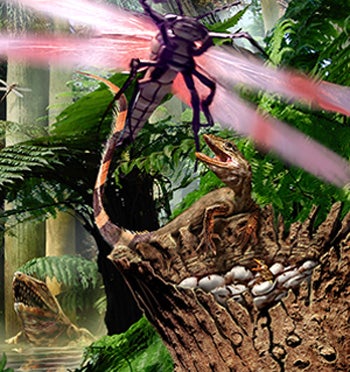
It's not all dinosaurs dinosaurs dinosaurs. This Carboniferous scene by Luis Rey depicts a menacing anthracosaur in the background, a nest-guarding early reptile, and a griffinfly (the better name for those 'giant dragonflies'). Waitaminute -- isn't that griffinfly a shopped image of a toy dragonfly? Err... Image (c) Luis Rey, from Luis's blog.
Bakker’s book is split into 13 sections, the shortest of which are only a page or two long, the longest of which span eight pages. We’re taken on a tour of evolutionary history that begins in the Devonian. Indeed, the first several pages cover fish, anamniotes (‘ancient amphibian’-type tetrapods), synapsids, the rise of diapsids, and the Triassic diversification of crocodile-group archosaurs.
Bakker’s text is surprisingly good. It’s lively, snappy, flows well, and he’s good at explaining complex ideas or concepts in simple and attention-getting ways. Describing synapsids as ‘one-holers’, diapsids as ‘two-holers’, and archosaurs as ‘three-holers’, for example, is actually pretty clever. These descriptors refer to the number of major openings in their skulls, lest you were thinking that they might be about something else...
I also think that Bakker should be credited for his often very ‘fair’ way of describing historical events. He notes those cases where different experts independently came up with the same conclusions or ideas, and mentions Hitchcock, Cope, Huxley and Ostrom. Mary Anning is the focus of several pages.
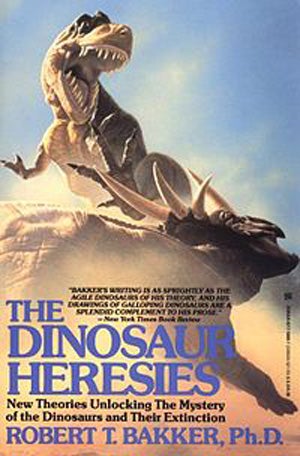
Some of you might have been introduced to Bakker's ideas on one or two previous occasions.
Of course, Bakker is also good at getting pet ideas into his popular texts, pet ideas that will seem too speculative, or not especially well supported, to many of his colleagues. There’s a bit of that in The Big Golden Book. Examples include his mention of the possibility that hadrosaurs used sound blasts in defensive fashion, and his ‘double-penguin’ argument about plesiosaur locomotion (this is the idea that plesiosaurs must have been even better at manoeuvring than extant penguins and pinnipeds: see Bakker 1993).
Naturally, endothermy for dinosaurs, the inclusion of birds within the dinosaurian radiation, Nanotyrannus as a valid and distinct entity, the concept of a fuzzy T. rex, and disease as a possible contributor to the end-Cretaceous event (as per Bakker 1986) are all promoted in the text. But, then, you didn’t expect any less, I hope, and at least some of these ideas – the dinosaurian nature of birds being paramount – can’t (or shouldn’t) be avoided in a book on dinosaurs. There are one or two things that might well be regarded as wrong: Bakker describes how sauropods relied on gizzard stones to mash up their food, for example, whereas recent studies have cast considerable doubt on that idea (Wings & Sander 2007).
Lest we think that Bakker is too confident in his assertions, I like very much the fact that there are places where he poses provocative ideas or questions that invite the reader to go away and think for themselves. Linked sections of text on p. 46 and p. 50 introduce readers to the concept of sexual selection and to the idea that a role in courtship or reproduction might drive the evolution of a structure... this all via questions posed about the unusual shape of T. rex.
All in all, I liked the text a lot more than I expected to. The cutesy nicknames given to many of the animals irk a little, but – given the text’s intended readership – I mostly have very positive feelings about it.
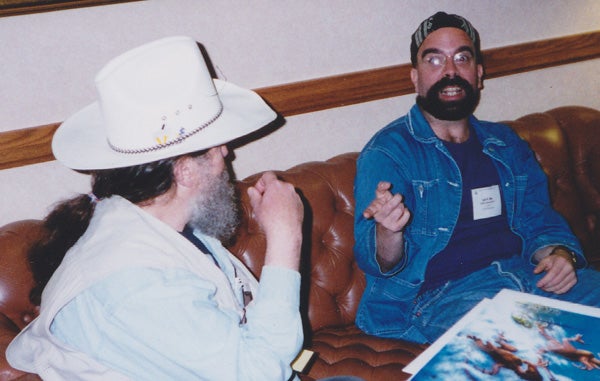
This book is the work of two people, and here's a rare photo of the two of them together (taken back in 1999). Robert Bakker at left, Luis Rey at right. Photo by Darren Naish.
But enough about the text. As is typical for so many children’s books on dinosaurs, this book is led by its pictures. The pictures are the most important thing, and a great many ‘readers’ will look at the book (perhaps innumerable times) without reading a single word. This is why it infuriates me that there are professional scientists who (when working as authors or consultants) sign off any old piece-of-crap illustration as if it doesn’t matter. No, the pictures are the most important part of a book for many people, not the least important!
Here we come to the elephant in the room: Luis Rey’s artwork. Luis and I go back a long way. We’re friends and allies, and we used to talk and correspond regularly about news from the Mesozoic world, about discoveries and ideas, and about the portrayal of dinosaurs and pterosaurs in art. But I have to confess that we’ve fallen out of touch over the last several years, wholly because Luis has switched to a sort of computer-augmented, digitally composited way of doing his reconstructions that, I’m sorry, I don’t personally find at all interesting or attractive.
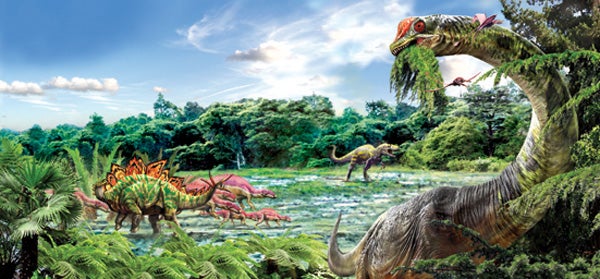
Luis's Late Jurassic Morrison fauna scene, super-saturated colours ahoy! This is the image used on the cover of the book, though one of the pterosaurs has been re-positioned. Image (c) Luis Rey.
Luis’s animals are often very accurate. Look at his sauropods, for example, and you’ll see accurate, columnar hands, and none of those extra claws and hooves that less experienced artists frequently insist on adding. The Chindesaurus that spans pp. 20-21 is more or less a classic Rey piece of his former style (bar the motion blurring and a tongue that seems to have been shopped in from a modern animal). He depicts what is very likely a reasonable amount of feathers, quills and filaments on those dinosaurs that should possess them. The maniraptorans are thickly plumaged and the tyrannosaurs have spiny quills. But I regret to say that there are things here that I personally dislike, and I just can’t pretend not to notice them.
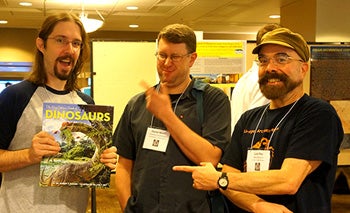
Left to right: Scott Hartman, Darren Naish, Luis Rey.
Incidentally, this is the reason that I've delayed writing this book review for so long. It also explains the look on my face in the adjacent photo. I apologise to Luis for being negative, but I have to be honest. The aim of this book was obviously to produce a modern-day, fully updated version of the Watson-Zallinger classic. In portraying vibrant, new-look dinosaurs that are quite radical in appearance compared to Zallinger’s depictions of 1960, the book does do just that... the problem is that Zallinger’s art is really beautiful and a joy to look at, despite the inaccuracy of his often fat, bland dinosaurs. I cannot regard Luis’s art in the same terms.
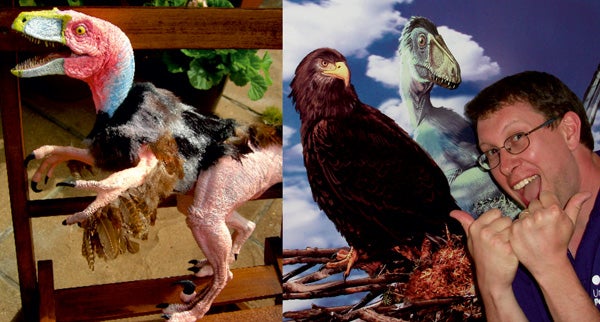
Personal encounters with Luis Rey artwork, of which I've had many. At left: Luis's customised Deinonychus model (it features in The Big Golden Book). At right: annoying human with a piece Luis produced for a previous book authored by Bakker.
But, Darren, this isn’t about you. Many things said about palaeoart are objective. It can be simply, truly wrong to depict certain animals in certain ways. But an interpretation of art is the very opposite of objective. Maybe my dislike of Reyified imagery is idiosyncratic on my part. And, in any case, this book was not written for people like me, but for kids. I conducted a simple experiment: I gave the book to my kids to see what they thought. I didn’t prejudice them in any way, but merely asked what they thought.
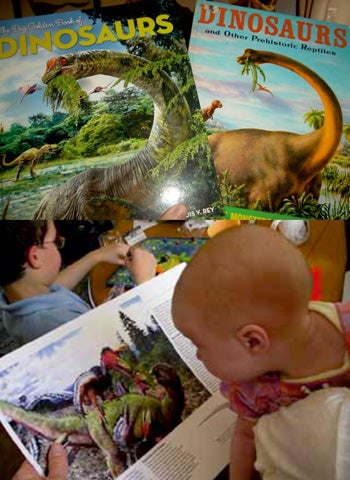
At top: Dinosaurs of 1960 vs those of 2013... how things have changed. Image shamelessly thieved from the LITC review. Thanks, guys. Below: a reminder (from 2009) that babies love Luis Rey.
Will (who’s 13) appreciated the compositions, was pleased to see renditions of ‘new-look’ dinosaurs (he was especially keen to see how Velociraptor was portrayed), and overall thought the book was pretty good. No negative comments; he gave it 6 out of 10. Emma (who’s 6) had positive things to say about the colours, the style of the illustrations, and “liked nearly every page”. Again, no negative comments. In fact, when asked to score it out of 10, she gave it 100.
I’m left with mixed feelings about Bakker and Rey’s Big Golden Book. I think it’s a fun read, I like the unapologetic radical new-look nature of its dinosaurs, and I like the way it’s structured and arranged – as a modern revamping of a much-loved classic. But I’m not a fan of the photo-mashup style that Luis has developed, and hence can’t and won’t look at this book for fun, pleasure or reference. But kids? My kids, at least, like it or love it. Maybe that’s the most important thing.
Robert T. Bakker. 2013. The Big Golden Book of Dinosaurs. Random House Children’s Books, New York. Hardback, index, pp. 61. ISBN 978-0-375-85958-8. Here at amazon. Here at amazon.co.uk.
For previous dinosaur-themed book reviews and related articles, see...
Getting a major chapter on birds - ALL birds - into a major book on dinosaurs
The changing life appearance of dinosaurs/Artistic Depictions of Dinosaurs Have Undergone Two Revolutions (original title still used because this is the one used in previous Tet Zoo link lists)
New Books on Dinosaurs 2: Dean Lomax and Nobumichi Tamura's Dinosaurs of the British Isles
Refs - -
Bakker, R. T. 1986. The Dinosaur Heresies. Penguin Books, London.
- . 1993. Plesiosaur extinction cycles - events that mark the beginning, middle and end of the Cretaceous. In Caldwell, W. G. E. & Kauffman, E. G. (eds) Evolution of the Western Interior Basin: Geological Association of Canada, Special Paper 39, 641-664.
- . 2013. The Big Golden Book of Dinosaurs. Random House Children’s Books, New York.
Holtz, T. R. 2007. Dinosaurs. Random House, New York.
Wings, O. & Sander, P. M. 2007. No gastric mill in sauropod dinosaurs: new evidence from analysis of gastrolith mass and function in ostriches. Proceedings of the Royal Society B 274, 635-640.
Watson, J. W. 1960. Dinosaurs and Other Prehistoric Reptiles. Golden Press, New York.